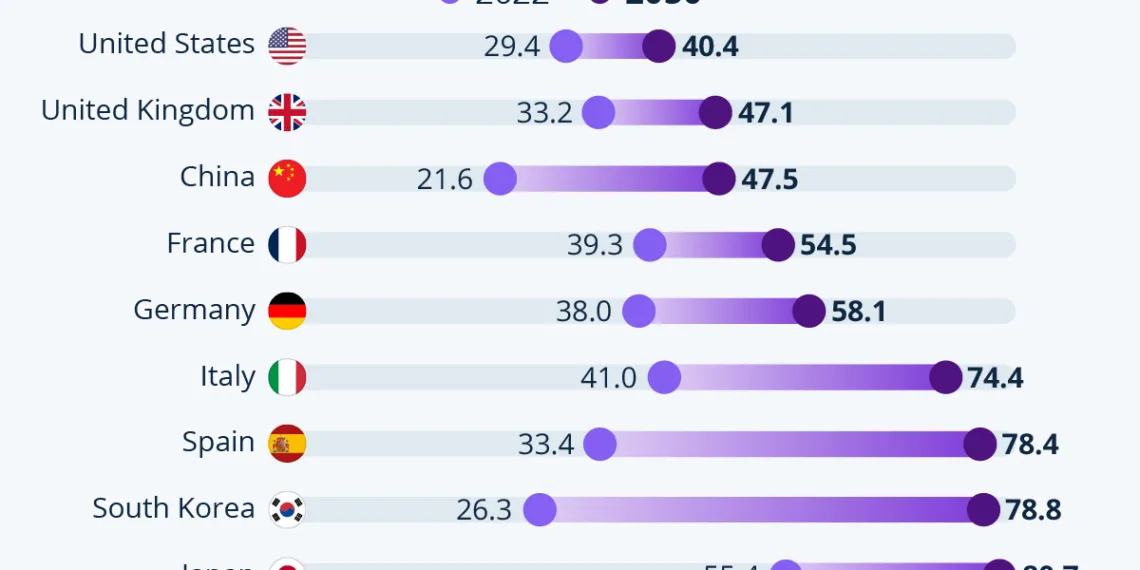The Looming Retirement Crisis: A Global Perspective
Understanding the Aging Population Phenomenon
As countries around the world grapple with significant demographic shifts, the aging population emerges as a pivotal issue. This transformation is not merely a statistical anomaly but heralds profound implications for economies, healthcare, and social structures. The confluence of falling birth rates and increased life expectancy is creating a landscape in which traditional support systems must evolve to adapt to new realities.
The Numbers Don’t Lie: Current Statistics
According to data from the OECD, the ratio of retirees to workers is already alarming in certain nations. In 2022, Japan recorded over 55 retirees for every 100 workers, while Italy’s figure stood at 41. By 2050, these numbers are projected to soar—Japan could witness a staggering 81 retirees per 100 workers, and Italy may see a corresponding rise to 74. These projections prompt crucial questions about the sustainability of current pension systems and the capacity of labor markets to support an increasingly aged population.
Countries on the Brink: Japan and Italy
Japan: A Case Study of Aging
Japan typifies the challenges posed by an aging population. Not only does it boast one of the highest life expectancies globally, but its low birth rate exacerbates the situation. The traditional family structure that once supported the elderly is also eroding, creating a reliance on institutional care that many are ill-prepared for. As the workforce shrinks, the burden on social security systems looms large, calling for urgent reforms.
Italy: Navigating Demographic Transition
Similarly, Italy faces profound challenges due to its aging populace. Cultural shifts, economic instability, and youth emigration have all contributed to a demographic landscape where fewer adults support an increasing number of retirees. The implications for the Italian pension system, alongside healthcare services, suggest a need for innovative approaches to care and support for this vulnerable population.
The Global Ripple Effect: Emerging Challenges
China: Rapid Transition to an Aging Society
China’s impending demographic crisis is shaped uniquely by its historical one-child policy, which has resulted in a population that is aging faster than anticipated. As life expectancy climbs, the nation confronts a shrinking workforce that poses grave challenges to its economic trajectory. The transition is particularly alarming given that China has enjoyed decades of economic growth, heavily bolstered by a large, youthful population.
South Korea: An Economic and Demographic Dilemma
South Korea is experiencing one of the lowest fertility rates worldwide, amplified by widespread economic challenges. The struggle for young couples to balance careers, housing, and costs associated with child-rearing is prompting a formidable decline in birth rates. The traditional societal structure, often difficult for women to navigate, further exacerbates this issue, positioning South Korea on a similar trajectory toward an aging society.
The Impact on Labor Markets
As workforces shrink, the implications for labor markets are profound. A rapidly aging populace necessitates an influx of younger workers to maintain economic productivity. However, few countries have cultivated policies robust enough to encourage higher birth rates or to attract immigrant labor that can fill these gaps. This scenario raises questions about how businesses will adjust to a reduced workforce.
Healthcare Systems Under Pressure
The dual challenges of an aging population and a shrinking workforce lead to increased healthcare expenditures. Aging individuals typically require more intensive medical care, shifting the burden onto public health systems already struggling with funding. Countries will need to innovate in healthcare delivery and consider how to manage long-term care for older adults effectively.
Rethinking Pension Systems
Pension systems worldwide face increasing strain as demographic trends shift. The traditional pay-as-you-go model, designed for a different demographic structure, is at risk of becoming obsolete. Policymakers are thus called to rethink pension arrangements, exploring options such as increased retirement ages, altered benefit structures, or alternative funding mechanisms to ensure sustainability.
Conclusion
The aging population is not just a localized issue but a global phenomenon that requires immediate attention and innovative solutions from governments and societies alike. The ramifications of this trend will shape economies, healthcare systems, and the social fabric of nations in the years to come. Addressing the challenges posed by an aging society is crucial to safeguarding future generations and ensuring a stable and prosperous future.






